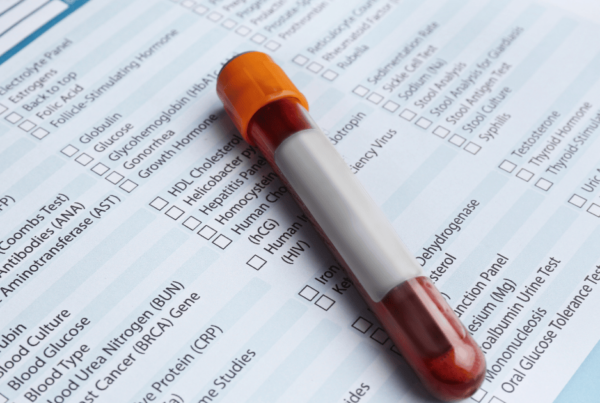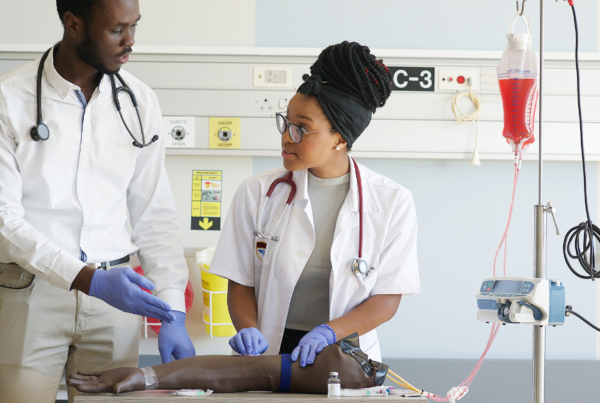Are you interested in a healthcare career that allows you to directly interact with patients and play a crucial role in their care? If so, then becoming a medical assistant or a phlebotomist could be a great fit for you! Both professions offer rewarding opportunities in the medical field, but with distinct responsibilities, training requirements, and work environments. This guide will explore everything you need to know about medical assistant vs phlebotomist, helping you decide which career path best suits your interests and goals.
| Key Takeaways: medical assistant vs phlebotomist |
| Both medical assistants and phlebotomists are vital healthcare professionals contributing to patient care. |
| Medical assistants have a broader range of duties, including administrative tasks, clinical procedures, and potentially phlebotomy. |
| Phlebotomists specialize in blood collection and other specimen collection. |
| Both careers require a high school diploma or GED and additional training. |
| Medical assistants typically complete a longer program (4 months – 2 years) compared to phlebotomists (weeks – months). |
| Phlebotomists undergo more extensive training in blood collection methods. |
| Medical assistants typically work in clinics or physician’s offices, while phlebotomists may find work in various settings including hospitals and diagnostic labs. |
| Both professions offer promising job growth and comparable salaries. |
Medical assistants and phlebotomists are both vital members of the healthcare team, contributing significantly to patient care. However, their specific duties and career paths differ. This section provides a quick comparison to give you a starting point:
| Feature | Medical Assistant | Phlebotomist |
| Description | Trained professional providing clinical care and administrative support | Healthcare professional specializing in blood collection and lab specimens |
| Average Salary | $42,000 (USD) | $41,810 (USD) |
| Projected Job Growth | 14% (2022-2030) | 8% (2022-2030) |
| Job Locations | Physician offices, urgent care clinics, outpatient centers | Hospitals, clinics, diagnostic labs, blood banks |
| Typical Hours | Regular weekdays, may vary | May be regular weekdays or shifts |
| Training | Formal program (4 months – 2 years) | Formal program (several weeks – months) |
Medical Assistant Overview
Medical assistants play a multifaceted role in clinics and healthcare facilities.Their duties cover a broad spectrum of activities, such as:
- Taking vital signs: Measuring patients’ temperature, blood pressure, pulse, and respiration.
- Recording medical history: Collecting patient information about their health conditions, allergies, and medications.
- Preparing patients for examinations: Assisting healthcare providers by getting patients ready for procedures.
- Helping physicians during exams: Providing support to doctors during patient consultations and examinations.
- Assisting with minor surgical procedures: Helping doctors with tasks during minor surgeries.
- Collecting and processing lab specimens: May collect blood and other samples for laboratory testing.
- Scheduling appointments: Managing patient appointments and scheduling needs.
- Handling billing, coding, and insurance claims: Processing medical billing and insurance paperwork.
Medical Assistant: Education and Training Requirements
To become a medical assistant, you’ll typically need a high school diploma or GED. Following that, you’ll need to complete an accredited medical assisting program. These programs can range from four months to two years depending on the chosen format (certificate vs. associate’s degree).
Medical Assistant: Work Environment and Schedule
Medical assistants typically work regular business hours in clinics, physician offices, or outpatient centers. However, some may need to work weekends or evenings depending on the facility’s needs.
Medical Assistant: Salary and Job Outlook
The median annual salary for medical assistants in the United States is $42,000 (USD) . The job outlook for medical assistants is promising, with a projected growth of 14% from 2022 to 2030 (faster than average) .
Phlebotomist Overview
Phlebotomists play a critical role in obtaining accurate laboratory results through blood draws and specimen collection. Their typical responsibilities include:
- Collecting blood and other specimens from patients: This is their primary function and involves efficiently drawing blood from veins or fingers using needles.
- Labeling and storing blood specimens: Ensuring proper labeling and storage of collected blood samples for accurate testing.
- Preparing blood specimens for transport: Preparing blood samples for safe and secure transportation to the laboratory for analysis.
- Maintaining equipment and inventory: Keeping phlebotomy equipment sterilized and maintaining adequate supplies.
- Educating patients about the lab work process: Providing patients with clear instructions and addressing any concerns they may have about blood draws.
Phlebotomist: Education and Training Requirements
To become a phlebotomist, you’ll need a high school diploma or GED. You must then complete a formal phlebotomy training program, which can be completed in a few weeks online or several months in a traditional classroom setting. These programs typically cover topics such as human anatomy, medical terminology, and proper blood collection techniques. In addition to coursework, many phlebotomy programs include an externship where students gain hands-on experience collecting blood specimens under supervision.
Medical Assistant vs Phlebotomist: Work Environment and Schedule
Phlebotomists can find work in various healthcare settings where blood draws are needed, including:
- Hospitals
- Urgent care clinics
- Diagnostic laboratories
- Blood banks
- Blood donation centers
Depending on the work environment, phlebotomists may work regular weekday hours or may have to work nights and weekends.
Phlebotomist: Salary and Job Outlook
The median annual salary for phlebotomists in the United States is $41,810 (USD). The job outlook for phlebotomists is very promising, with a projected growth of 8% from 2023 to 2030 (much faster than average).
Important Similarities Between Medical Assistants vs Phlebotomists
Despite their distinct roles, medical assistants and phlebotomists share some key similarities:
- Essential patient care duties: Both professions contribute significantly to patient care, ensuring smooth operations within healthcare facilities.
- Specialized training required: Both medical assistants and phlebotomists must complete formal training programs after high school to qualify for their respective positions.
- Strong people skills: Both roles require excellent communication and interpersonal skills to interact effectively with patients and other healthcare professionals.
- Adaptability and stress management: The ability to handle unexpected situations and work well under pressure is crucial for both medical assistants and phlebotomists.
- Understanding medical terminology: A basic understanding of medical terms is essential for both professions to effectively communicate with colleagues and patients.
- Blood draw capabilities: While phlebotomy is their primary function, some medical assistants may also be trained and certified to collect blood under a physician’s supervision.
Important Similarities Between Medical Assistants vs Phlebotomists
While there’s some overlap, there are also significant differences between these two healthcare careers:
- Range of duties: Medical assistants have a more diverse range of responsibilities compared to phlebotomists. In addition to blood collection, they may perform administrative tasks, assist with procedures, and take vital signs.
- Depth of blood collection training: Phlebotomists receive more specialized training in blood collection techniques than medical assistants due to their focused role.
- Work environment: Medical assistants typically work in clinics or physician’s offices, while phlebotomists may find work in a wider range of settings, including hospitals and diagnostic labs.
Salary and Job Growth Comparison: Medical Assistant vs Phlebotomist
Both medical assistants and phlebotomists enjoy a stable job market with comparable salaries and promising job growth. Here’s a quick comparison:
| Feature | Medical Assistant | Phlebotomist |
| Median Salary | $42,000(USD) | $41,810 (USD) |
| Projected Job Growth (2022-2030) | 14% | 8% |
Requirements for Medical Assistants and Phlebotomists Regarding Education and Training
As mentioned earlier, both professions require a high school diploma or GED as a base requirement. However, their training paths differ significantly:
- Medical Assistant: Medical assistants typically complete a formal program that can range from four months to two years, depending on the chosen format (certificate vs. associate’s degree). These programs cover various medical assisting skills, including administrative tasks, clinical procedures, and phlebotomy techniques (in some programs).
- Phlebotomist: Phlebotomists typically complete a shorter, more focused training program compared to medical assistants. These programs range from a few weeks online to several months in a traditional classroom setting. They cover essential topics like human anatomy, medical terminology, and proper blood collection techniques. Many phlebotomy programs also include an externship component where students gain hands-on experience under the supervision of a qualified phlebotomist.
A Day in the Life Comparison: Medical Assistant vs Phlebotomist
While both medical assistants and phlebotomists play vital roles in healthcare, their daily tasks can differ. Here’s a general comparison:
| Comparing a Day in the Life | |
| Medical Assistant | Checking patients in and taking vital signs. |
| Assisting physicians with examinations and procedures. | |
| Preparing patients for procedures. | |
| Collecting and processing lab specimens (if certified). | |
| Scheduling appointments and managing patient records. | |
| Handling billing, coding, and insurance claims. | |
| Phlebotomist | Collecting blood and other specimens from patients. |
| Labeling and storing blood samples according to protocols. | |
| Preparing blood specimens for safe transport to the lab. | |
| Maintaining phlebotomy equipment and ensuring adequate supplies. | |
| Educating patients about the blood draw process and addressing any anxieties. | |
Selecting Between a Phlebotomy and Medical Assistant Career
Choosing between a medical assistant and phlebotomist career path depends on your interests and goals. Here’s a breakdown to assist in your decision:
| Career | Pros | Cons |
| Medical Assistant | More diverse job duties, potential for career advancement with additional training, broader work environment options. | Longer training programs may require more generalized medical knowledge. |
| Phlebotomist | Faster training program, focused skill set with high demand, opportunity to work in various healthcare settings. | Limited job duties, less potential for career advancement within the field. |
In Conclusion
Both medical assistants and phlebotomists are valuable members of the healthcare team, contributing significantly to patient care. If you enjoy interacting with patients, have a knack for detail, and want a fast-paced career path in healthcare, then either medical assisting or phlebotomy could be a great fit for you. Consider the factors discussed above, research further to learn more about each role, and choose the career path that best aligns with your long-term goals and interests.
FAQs: medical assistant vs phlebotomist
Which career path is faster to enter?
Phlebotomy typically has a faster entry path with shorter training programs compared to medical assisting.
Do I need to be good with blood to become a phlebotomist?
While some people may feel squeamish around blood, phlebotomy training equips you with the skills and techniques for successful blood draws. Many phlebotomists overcome any initial anxieties through practice and develop a professional demeanor when working with patients.
Can medical assistants become phlebotomists?
Yes, some medical assistant programs include phlebotomy training as part of the curriculum. Additionally, some medical assistants may pursue separate phlebotomy certification to expand their skill set.
Can phlebotomists become medical assistants?
While less common, phlebotomists with relevant experience can pursue additional education and training to become medical assistants.
Which career offers more opportunities for advancement?
Medical assistants have a wider range of job duties and more opportunities for career advancement with additional training or certifications. They may move into roles like medical office manager or health information management specialist. Phlebotomists can advance by becoming certified phlebotomy technicians with additional training.
Remember, the best career path depends on your interests and goals. Consider the factors mentioned above, research further, and choose the option that aligns best with your aspirations.
Pursue a Rewarding Career in Phlebotomy with Phlebotomy Now School
Ready to launch your career in phlebotomy and become a sought-after healthcare professional? Phlebotomy Now School can equip you with the skills and knowledge you need to succeed. Our accredited phlebotomy training programs are designed to be flexible and convenient, allowing you to enter the workforce quickly. We offer online and on-campus programs that cater to various learning styles and schedules.
Here’s what sets Phlebotomy Now School apart:
- Experienced Instructors: Our instructors are seasoned phlebotomy professionals who share their expertise and industry knowledge with our students.
- Hands-on Training: We emphasize practical experience through our comprehensive labs and externship placements, ensuring you graduate confident in your abilities.
- Career Support Services: We provide dedicated career support services to help you connect with potential employers and land your dream job as a phlebotomist.
Make the initial move in the direction of a rewarding career in healthcare. Contact Phlebotomy Now School today to explore our phlebotomy training programs and get started on your journey to becoming a certified phlebotomist!







